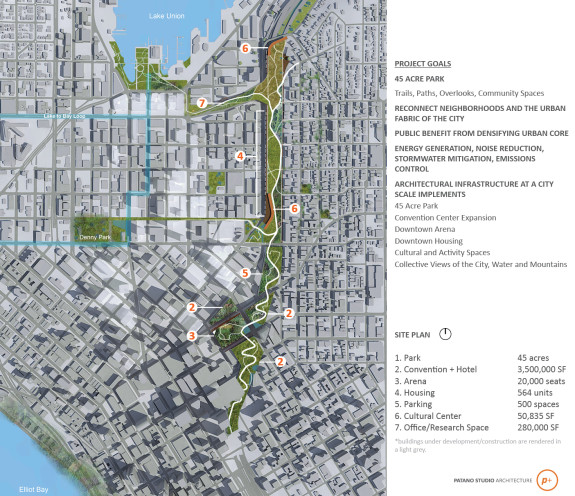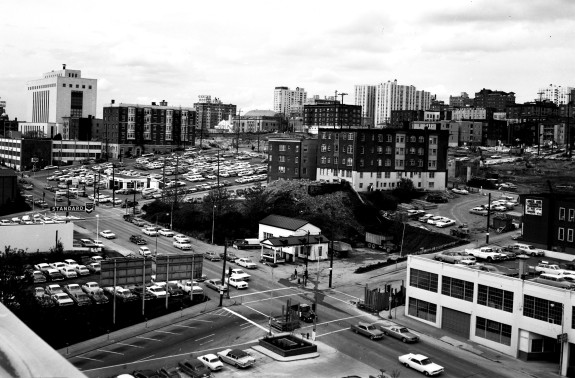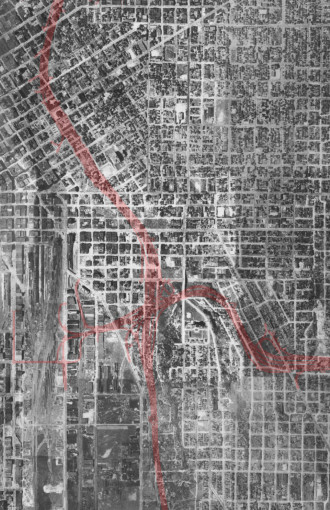
In some places I-5 is a trench. Other places, it’s a wall. Every once in a while, a bridge spans the rushing flow of motor vehicles or a street travels under the immense elevated wonder. But more often than not, I-5 divides communities, destroys biking and walking connections, and covers nearby blocks with constant air and noise pollution.
Aside from the tax dollars we spend to keep I-5 functional, we also pay an immense cost to deal with its other negative impacts on our communities. The freeway also occupies acres of some of the most valuable land in the city.
I know that when a major piece of infrastructure has been such a core part of a city for 50 years it can be hard to imagine things being different. From Denny Way to Lakeview, there’s just no way to get from South Lake Union to Capitol Hill. That’s just how it is.
But it doesn’t need to be that way.
As Capitol Hill Seattle reported in November and the Stranger expanded on this week, there is renewed energy behind the idea that we can lid I-5 in the center city area, complete with an expanded Convention Center, new biking and walking connections, acres of new park and maybe even an arena and affordable housing.
If something like Patano Studio’s C.A.P.ITOL HILL PARK concept were built, it’s very hard to fully understand the immense impact it would have on our city. In fact, the reverberations of such a project are so hard to measure we should move forward and fund a study of potential options and their effects on everything from public health to housing to public revenue.
There’s already a strong push from the Pike/Pine Urband Neighborhood Council for a study of a smaller lid near the Convention Center as part of its expansion plans. That’s a great place to start. Let’s keep going. As Scott Bonjukian wrote at the Urbanist, the time to act is now.
Seattle is different city today


Seattle has changed since I-5 was built. It is much denser, and the city’s transportation future relies on more transit, walking and biking. The city center is the state’s largest employment engine, and it’s obvious we can’t grow it by adding more cars than we already have.
By contrast, the photo above shows what downtown Seattle looked like when I-5 was under construction. Like so many other cities, people believed tearing down buildings to make space for car parking and bigger roads was going to be the future of city centers.
In retrospect, that decision was very short sighted. It has taken a long time for Seattle to rebuilt a dense city center. Many other cities with less investment power than Seattle, like my hometown St. Louis, are having a lot of trouble reviving their city centers.
Meanwhile, Vancouver BC is a flourishing example of a similar city that did not build urban freeways. They are now working to remove the only freeway-like remnants they built in order to build more city in its place.
But we can look back second guessing urban planning choices forever. Seattle has I-5. The relevant question is what we’re going to do next.
“Seattle is greeting new residents at a rate not seen since the gold rush of the early 1900s,” wrote Bonjukian. “The Center City … is now so intensely developed that there are few vacant sites left for new buildings. But growth will continue for the foreseeable future, and the unused airspace over Interstate 5 will inevitably beckon developers and city planners.”
The new park space could also fill a major urban need missing from Seattle today: A large central downtown park. The small triangle Westlake Park tries to fill this role today, but it’s just not good enough. Cal Anderson also tries, but it’s perhaps more of a neighborhood park than a civic center park.
“Establishing a large urban park in Downtown would be one of the most transformative capital projects in Seattle’s history, and there’s only one place it could go,” wrote Bonjukian.
I-5 is going to need significant paving and rebuilding work before too long, and building this lid needs to be part of that work. The more we can understand about the feasibility, costs and benefits the more ready we can be to include a plan in that work.
The freeways were our nation’s wonders of the 20th Century. But magnificent cities will be our wonders of the 21st Century. And lidding I-5 is just the start.








Comments
25 responses to “Rethinking Seattle Freeways: Let’s lid I-5”
Sounds like a nice idea – but who would be paying for this, and how many miles of subway and bike lanes could the money buy instead?
There are a lot of questions to answer.
If I had my way, the state would see that this is an important part of their next phase of freeway work. Perhaps also with some tax-increment financing and selling new developable land.
But a study would need to look at all the numbers and all the options for funding it.
The specifics are not very impressive.
According to the proposed map, nothing would be lidded south of the current lid at Seneca.
This proposal isn’t meant for downtown at all. Instead its a way to extend the development windfall from SLU up to the Cascade neighborhood, and across to Capitol hill.
If it were a serious proposal, the meandering sidewalk/bike lane would be straight, and extended south past Harborview and end up in Yesler terrace/Dearborn, connected to MTS trail and Streetcar.
South of Marion the freeway is elevated rather than trenched, and it’d be strange to say the least to have a park atop an elevated freeway atop city streets like James and Cherry. Now if we’re talking either removing I-5 or redecking it at or below-grade, by all means restore the full grid and slap a park on top. Where do I sign?
I have a fantastic way to pay for this!! For every 10 hours a sidewalk or bike path/trail is closed (let them ‘rent’ the space!) or special noise permits are needed for construction charge a sizable fee to be used for parks! Why are peds, cyclist, neighbors suffering and paying for mega profits for property dealers?
Is it necessary that it be a park? We built the Convention Center over the highway, can’t we build some apartments, offices, coffee shops, shops, bars, etc. over it, too?
If we did that, we could actually sell the new land to pay for the construction, and it’d be in pretty prime location, too.
Agreed. Washington DC just sold the air rights over a 3-block stretch of I-395 downtown. The city is getting a new lid, with open space and cross-streets, paid for by developers instead of taxpayers. Seattle should definitely investigate the potential to do the same.
Convention center expansion also makes this a great time to take this on. Mitigation dollars from the expansion should be able to fund a small portion of the lid, and every little bit helps.
+1. I’m not sure what buildings on the slope between SLU and Capitol Hill would look like, but Seattle should definitely look into it. If someone’s interested – especially someone who can put in a hillclimb like some downtown buildings – it’d be great.
Sorry, but a large scale project of that nature would make traffic in the downtown area 10 times worse than it is already. It isn’t worth the money or frustration, IMHO.
Let’s focus on the big money projects already in the works before we start new ones. I’d rather see light rail/link on West Seattle and Ballard before this.
+1 for this,
You don’t have to super densify downtown if you can reach it quickly without having to drive. That means extending Light rail from West Seattle down to to White Center perhaps connecting at the Airport (gasp! a transportation hub!) passing within walking distance of the Vashon ferry, going to Renton and up to Bellevue, Kirkland, Bothell, Woodenville, Mill Valley out to Issaquah and possibly North Bend. ie a huge connected rail system.
When I-5 needs to be rebuilt, the need for it will be less if we have all of this rail going everywhere. Housing would be lower cost as everyone wouldn’t have to live on Capital hill in order to “walk” to work.
I was looking at the concept image and, after looking at google maps earth, I realized how little green there was in that area. I guess it just wasn’t something I considered until now. That said, I agree with Jeff Dubrule that at lease some portion should be used for structures like coffee shops, eateries, and affordable housing (preferably for public and semi-public employees like teachers, police, etc. IMO). Whatever the case, lidding sounds great.
This is a great idea but I have a better one, lets close I-5 and double or triple deck I-405 (or even skip that part).
I suppose we could keep it open to the stadiums and the port on the South and open to Northgate, but shut down the rest and convert it back to medium density residential and mixed land uses maybe using some sort of performance/form based land use code ( http://formbasedcodes.org/definition ).
Let’s try and be Vancouver BC for a bit.
Or let’s shut down I -5 and I-405!
Any reason you’d just push the traffic over to the east? Seems a little provincial and uncharitable.
remember the great artist concepts of the waterfront, lots of grass and people walking around? well it is being replaced by a huge road at taxpayers expense. the lid over i-5 won’t be a park but a developers dream paid for by the taxpayers!
And the image of those old street cars running up a dual track…. well they sold 3 of the 5 and now are looking for $50k to retro fit the other two so that they can be run on 1st Ave with the yet to be built 1st Ave Street car.
Thanks for covering this Tom, and glad I could provide you some quotes! I’m a little skeptical of Patano’s particular proposal right now and believe PPUNC has the more realistic and timely concept, but I appreciate the coverage nonetheless. Please get in touch if you have any other questions.
We don’t need more parks. We need more housing. Put up a park here, and perhaps people can enjoy it on their lunch break before commuting back to Renton or Federal Way. Since that’s where they’ll have to go to afford a place to live.
Why does the Seattle “green” crowd always insist on a park instead of housing? Why are the clowns in Roosevelt insisting on a park instead of housing? Why isn’t a plan to lid I-5 (great idea!) with a park (terrible idea) laughed at by our supposedly progressive press, like the Stranger?
Housing housing housing housing housing housing. House people more densely and cheaply and so many of these problems we claim to care about are more easily solved.
+1
Lid or no, isn’t the space directly over a freeway going to have some of the worst air quality in town? Is that really where we should build a park?
This is doubly true for housing.
My understanding of Utrecht’s new freeway tunnel/lid is that they filter and scrub the air from the tunnel, so air quality is a benefit.
Surely it would be better to start by filling in missing bridges in many locations other than only downtown?
There’s a huge missing bridge gap between Denny and Lakeview. We could start there!
meanwhile, bertha sits underground…..
[…] unlike with I-5, it won’t take a multi-billion-dollar project to fix Aurora. Instead, all we have to do is […]